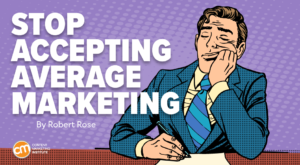
As agile becomes more and more the norm in marketing departments, is it time for marketers to have their own framework? It’s been the common practice for marketers to cobble together parts of Scrum and pieces of Kanban and to figure out what resonates with them, but is that good enough, or would a framework that’s designed just for marketers by marketers be a better solution?
The question that I get asked in almost every training session is something like, “I love the idea of agile marketing, but what’s the best way to implement it at my company?”
Leaders in the agile marketing community have been meeting regularly to discuss many of the pain points associated with marketers and what needs to change to make lasting change.
“Marketing professionals face some serious challenges today. Agile marketing gives marketers the ability to be effective communicators with their stakeholder groups. Stakeholders no longer feel like they’re being marketed to; instead, they understand that they’re part of an ongoing conversation between them and the marketer. Adding an agile marketing framework would be a good step for marketing as the profession deals with the challenges facing the practice today,” says John Cass, co-founder of AlContentGen and a prominent leader in the agile marketing community.
The challenges with Scrum
I’ve always been a huge proponent of Scrum, and it absolutely can work for marketing teams when implemented well. But a lot gets lost in translation. It can easily be adapted for marketers with the luxury of a coach to help them make it applicable to marketing. However, companies without a guide often struggle to bring it to life in their world.
One of the key missing ingredients with Scrum for marketing is that the framework begins with the team’s backlog. Still, it doesn’t address anything that occurs upstream with how work originates and gets to the teams. When the practice starts there, marketers still don’t have a seat at the table.
In my experience, great agile marketing begins when marketers work with stakeholders early on to align on the desired outcomes of a project or campaign, allowing the team members to ideate on how they would go about creatively solving the problem.
At most companies, work is submitted through a brief, and the creative team is expected to execute to the exact specifications. What’s hugely missing here is the conversation around the business goals.
So if I were to create an agile marketing framework, it would begin with collaborative planning between the stakeholders and the team, where they go back and forth between outcomes and creative solutions, leaving with shared alignment and understanding.
Another gap I’ve noticed with Scrum for marketing is the timing around feedback loops. While the Sprint Review was designed for product development teams to get feedback on what was completed with a product, typically taking several sprints to build and release, marketers have much quicker execution times, which often involve multiple customers and channels. So the Sprint Review may be a moot point for marketing because they likely have several campaigns in flight at any given time.
What marketers do need to focus on, however, is how those campaign assets are performing at any given time. So instead of the traditional Sprint Review, a tweak in marketing would be looking at how campaigns are doing, and using that data to drive conversations.
Scrum roles aren’t apples-to-apples in marketing either. While the idea of a dedicated Scrum Master that doesn’t do work is great, marketing teams are so lean that this seldom happens unless it’s a very large company.
With my clients, I often create a role called “Agile Champion,” and that’s the person on the team who will champion new ways of working but still does work themselves. This practice seems much easier to implement. The person in that role feels empowered to lead change but doesn’t feel like they have to master a new job altogether.
The role of Product Owner doesn’t always resonate with marketers since they aren’t out there looking at a vision for a new product. However, I’ve often used “Marketing Owner,” which is quite similar. However, a marketing strategist typically fills it, and their role doesn’t change too much, except they become the one person that prioritizes the team’s backlog.
Blending in Kanban
Most of the time, Kanban alone doesn’t solve the challenges marketers face because there isn’t adequate planning and stakeholder engagement. Nevertheless, a few practices from this framework greatly benefit marketers.
The ones I’ve found most useful to incorporate are: visualizing the work, work item types, measuring cycle time and setting work in progress limits. By visualizing work, teams can understand where work is at any point in time. Work item types (such as a social post or blog) are great for understanding individual efforts and process inefficiencies. Measuring cycle time allows teams to understand how long a work item type takes to complete and streamline the flow. Setting work-in-progress limits helps teams finish the task rather than starting too many tasks at once.
I would build all of these practices into a unique framework just for marketers. Today, we’re telling marketers to figure it out, but would historical experience from agile marketing leaders help take the guesswork out of everything?
Read next: More on agile marketing from Stacey Ackerman
The evolution of agile marketing
In 2021 marketers came together to revamp the Agile Marketing Manifesto during a community event called #sprinttwo. We’ve come a long way in alignment with values and principles as a community, but we don’t have any standard practices.
“Marketing is a unique organizational function, and I’ve never seen two departments built the same. There’s excellent alignment and consistency with agile values and principles as air-cover to guide modern marketing. However, the execution team’s challenge is in mapping and working with methods not designed for the specifics and overall breadth of marketing,” says Michael Seaton, president at Level C Digital and agile marketing coach and trainer.
What do you think — do marketers need their own agile marketing framework?

Many marketers struggle to apply agile marketing in a way that adds value to team members. Learn how to break that pattern in this free e-book, “MarTech’s Guide to agile marketing for teams”.
Opinions expressed in this article are those of the guest author and not necessarily MarTech. Staff authors are listed here.




